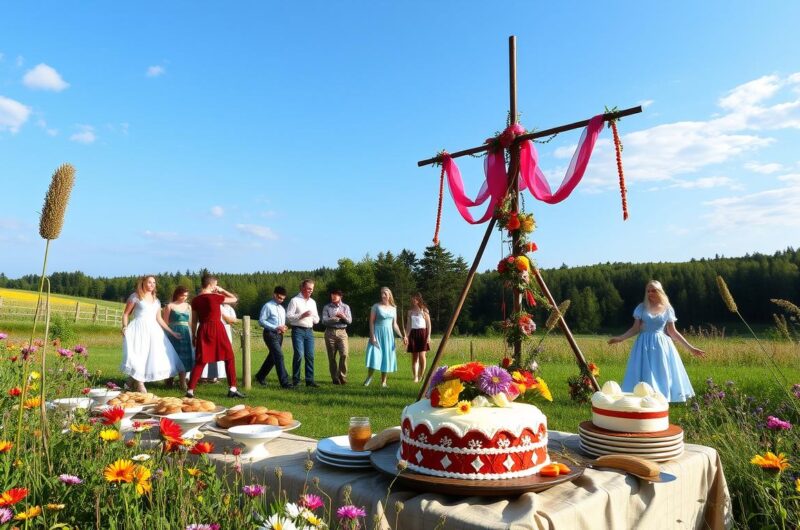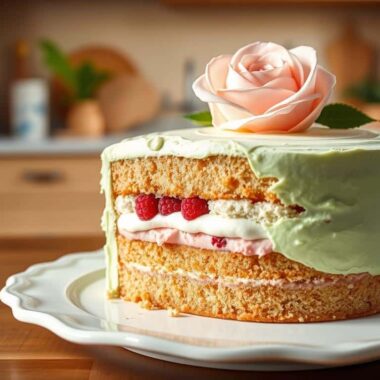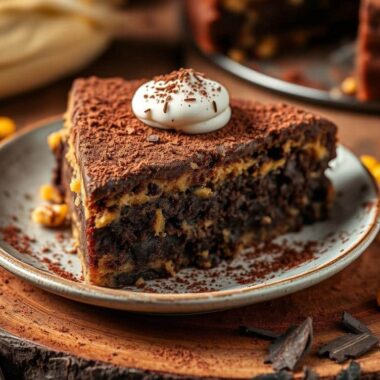Did you know the Princess Cake, or “prinsesstårta” in Swedish, is named after Swedish princesses? This delightful cake, with its green marzipan, is a symbol of Swedish culture. It’s loved by many for its royal look and tasty flavors.
The Princess Cake’s story starts in the early 1900s. Swedish chef Jenny Åkerström created it, inspired by the royal family’s elegance. It quickly became a favorite among Sweden’s elite and a symbol of national pride.
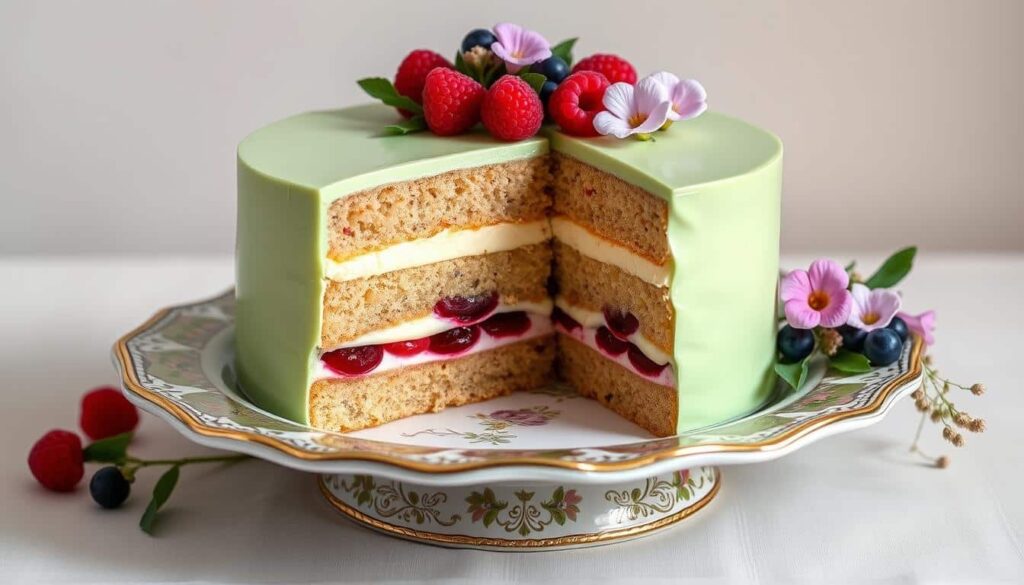
Key Takeaways
- The Princess Cake is a beloved Swedish dessert with a royal connection.
- It features distinctive layers of sponge cake, whipped cream, and a green marzipan coating.
- The cake was inspired by the elegance of the Swedish royal family and became a symbol of national pride.
- The Princess Cake has gained global popularity, with variations and adaptations emerging around the world.
- The cake’s unique appearance and delicious flavors have made it a cherished part of Swedish culinary culture.
The Origins of the Princess Cake
The Princess Cake, or prinsessktårta in Swedish, has deep roots in Sweden’s culinary history. It started in the 1930s with Jenny Åkerström, a Swedish home economics teacher. She created the cake, inspired by the Swedish royal family and her dream of making a cake for princesses.
Åkerström’s recipe mixed sponge cake, whipped cream, and green marzipan, topped with powdered sugar. This cake quickly won over the Swedish people with its beauty and taste. It became a national treasure.
| Key Ingredients | Traditional Preparation |
|---|---|
| Sponge cake | Light and airy texture |
| Whipped cream | Creamy and lightly sweetened |
| Green marzipan | Delicate almond-based coating |
| Powdered sugar | Dusted on top for a finishing touch |
The Princess Cake’s lasting appeal comes from its mix of flavors and textures. It’s also tied to the Swedish royal family. Today, it’s a key part of Swedish culture and a must-try for those exploring Nordic cuisine.
The Princess Cake’s story is a testament to innovation and tradition. It shows the lasting charm of Jenny Åkerström‘s 1930s pastry – a true royal dessert for Swedish princesses.
Cultural Significance in Sweden
The Princess Cake is a beloved part of Swedish culture. It’s deeply connected to the country’s fika traditions. Fika is a daily coffee break with a sweet treat, a key part of Swedish social life.
The Cake, with its royal connection and tasty flavors, is a big part of this tradition.
The Princess Connection
The Princess Cake’s story starts in the early 1900s. It was made to honor a Swedish princess. This royal connection made it a national treasure, symbolizing Swedish pride and tradition.
The cake’s green marzipan looks like a princess’s dress. This adds to its royal feel.
Evolution Over Time
Over the years, the Cake has changed but stayed true to its roots. The basic ingredients are still the same: a light sponge cake, whipped cream, and marzipan. But bakers have tried new flavors and looks.
Now, you can find vanilla, chocolate, or berry-filled Princess Cakes. It’s a national cake that still excites Swedish palates.
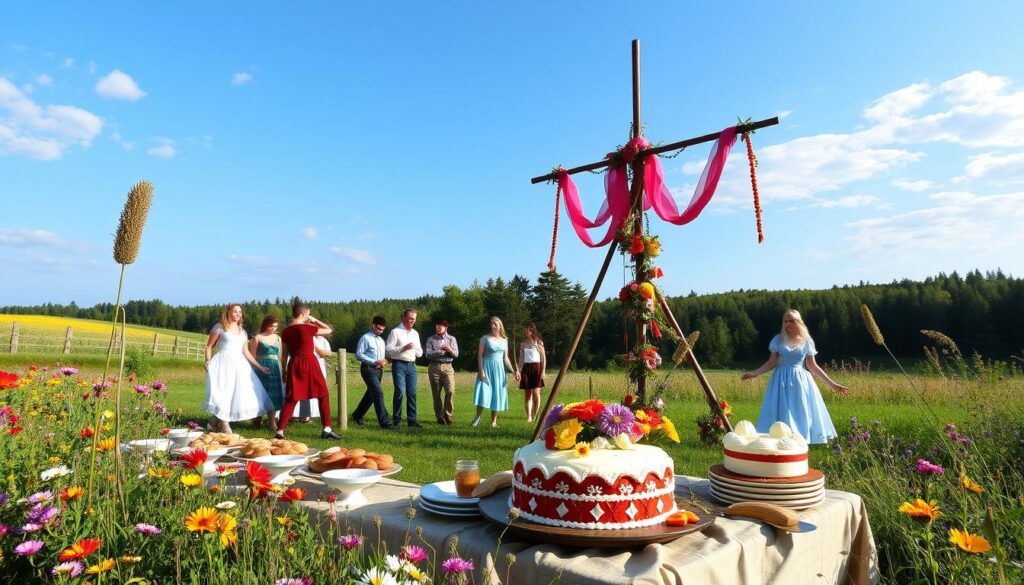
Today, you can find Princess Cake everywhere in Sweden. It’s a favorite in bakeries, cafes, and homes. It’s enjoyed during fika or at special events.
This sweet treat is a big part of Sweden’s food heritage. It shows the country’s royal patronage and Swedish traditions.
Components of a Princess Cake
A traditional Princess Cake, also known as a Prinsesstårta, is a delightful Swedish dessert. It combines flavors and textures in a harmonious way. The cake has several layers that come together to create a captivating experience.
Layers of Delight
The cake starts with a moist and tender sponge cake. This sponge cake is light and airy, making a great base. It’s then layered with a luscious vanilla custard, known as vaniljkräm, and smooth whipped cream.
The final layer is a vibrant raspberry jam. It adds a burst of fruity sweetness to the cake.
The Role of Marzipan
The most distinctive element of Cake is its stunning green marzipan coating. This almond-based confection is carefully crafted and applied. It creates a visually striking and elegant appearance.
The marzipan adds a beautiful presentation and a delicate, nutty flavor. This flavor perfectly complements the other components of the cake.
| Ingredient | Purpose |
|---|---|
| Sponge Cake | Provides a light and airy base for the cake |
| Vanilla Custard | Adds a creamy, custard-like texture and flavor |
| Whipped Cream | Adds a luxurious, velvety mouthfeel |
| Raspberry Jam | Introduces a burst of fruity sweetness |
| Green Marzipan | Delivers a distinctive and elegant appearance, as well as a delicate, nutty flavor |
The harmonious combination of these layers makes the Cake a beloved Swedish dessert. Each layer adds its unique flavor and texture.
Global Popularity of Princess Cake
The Princess Cake, a beloved Swedish treat, has won hearts around the world. It’s a top pick among desserts globally. This shows how fusion cuisine and celebrity chefs can make a big impact.
Variations Around the World
In Sweden, the Princess Cake is a treasured tradition. But, it’s also inspired bakers everywhere. They mix the cake’s essence with local tastes and seasonal variations.
- In Japan, bakers blend the Cake with Japanese sponge cakes for a unique taste.
- In the U.S., famous celebrity chefs add their twist, using different fillings and toppings.
- Across Europe, chefs use the Princess Cake as a base for international desserts, adding local touches.
Famous Occasions Featuring Princess Cake
The Cake is a hit at big events. It’s perfect for royal weddings and top culinary contests. It adds a touch of magic to any celebration.
| Event | Significance |
|---|---|
| The Wedding of Crown Princess Victoria of Sweden | The Princess Cake was the star at this royal wedding, proving its national importance. |
| The James Beard Foundation Awards | At this big food event, the Princess Cake was a highlight, loved by celebrity chefs and food lovers. |
Modern Adaptations and Twists
As more people love the Princess Cake, chefs are getting creative. They make vegan, gluten-free versions and new fusion cuisine takes. The Princess Cake keeps surprising and delighting foodies everywhere.
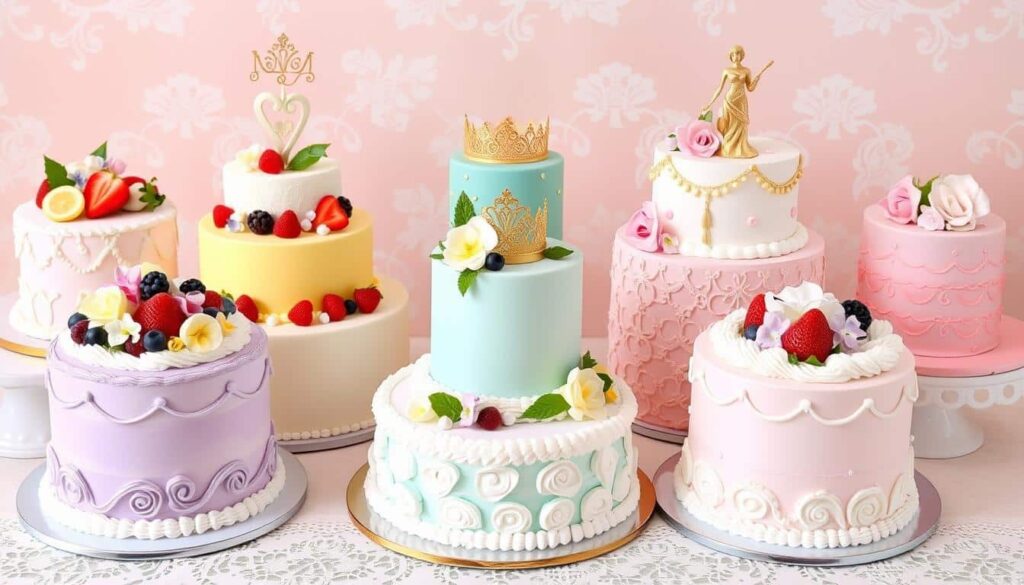
“The Princess Cake is a culinary canvas that allows us to explore the boundless possibilities of international desserts. With each new interpretation, we uncover new layers of flavor and artistry.”
–Renowned Pastry Chef, Julia Bakes
How to Make a Swedish Princess Cake: Ingredients and Instructions
Creating a Swedish Princess Cake, or Prinsesstårta, may seem like a daunting task, but with the right ingredients and clear instructions, it’s surprisingly manageable. This iconic dessert is a blend of delicate sponge cake, creamy custard, whipped cream, and a stunning marzipan cover. Here’s how to make it step-by-step:
Ingredients
For the Sponge Cake:
- 4 large eggs
- 1 cup (200g) granulated sugar
- ½ cup (65g) all-purpose flour
- ½ cup (65g) cornstarch
- 1 teaspoon baking powder
- ¼ teaspoon salt
For the Custard Filling:
- 1 cup (240ml) whole milk
- 4 large egg yolks
- 2 tablespoons cornstarch
- ¼ cup (50g) granulated sugar
- 1 teaspoon vanilla extract
Stabilized Whipped Cream:
- 2 cups (480ml) heavy cream
- ¼ cup (30g) powdered sugar
- 1 packet (0.25 oz) unflavored gelatin
- 2 tablespoons cold water
The Marzipan Cover:
- 1 lb (450g) marzipan
- Green food coloring
- Powdered sugar (for rolling)
- Optional: pre-made sugar roses for decoration
Instructions
- Prepare the Sponge Cake:
Preheat your oven to 350°F (175°C). Grease and line a 9-inch springform pan with parchment paper. In a mixing bowl, beat the eggs and sugar until pale and tripled in volume. Sift together the flour, cornstarch, baking powder, and salt, then gently fold it into the egg mixture. Be careful not to deflate the batter. Pour the batter into the prepared pan and bake for 25–30 minutes. Allow it to cool completely before slicing into three thin layers. - Make the Custard Filling:
In a saucepan, whisk together the milk, egg yolks, sugar, and cornstarch. Cook over medium heat, stirring constantly, until thickened. Remove from heat and stir in the vanilla extract. Cover with plastic wrap directly on the custard’s surface to prevent a skin from forming, then refrigerate until cool. - Whip the Cream:
Dissolve gelatin in cold water and heat for a few seconds until liquid. Whip the heavy cream and powdered sugar to soft peaks, then gradually add the liquid gelatin while whipping to stiff peaks. - Assemble the Cake:
Place the first sponge layer on a serving plate. Spread with raspberry jam, then half the custard. Add the second layer, repeat, and top with whipped cream. Smooth into a dome shape. - Cover with Marzipan:
Tint marzipan green and roll it into a large circle. Gently lay it over the cake, trimming excess. Decorate with sugar roses.
This Princess Cake is sure to dazzle with its balance of flavors and visual appeal!
Layers of Flavor and Craftsmanship
The Princess Cake is as much about its intricate assembly as it is about its taste. It features a delicate sponge cake layered with luscious vanilla custard and a dollop of tart raspberry jam, all enveloped in light whipped cream. The crowning glory, of course, is the smooth marzipan coating, usually dyed a characteristic pale green and adorned with a pink rose on top. These elements work harmoniously, resulting in a cake that is both visually stunning and a joy to savor.
Not only does its taste captivate, but the effort that goes into making the Cake also speaks volumes about its significance. From carefully folding the sponge batter to whipping the cream to the perfect consistency, every step demands patience and precision. Nevertheless, the end result is truly worth the effort.
Nutritional Content (Per 100g)
- Calories: 310 kcal
- Protein: 4.2 g
- Carbohydrates: 41 g
- Fats: 15 g
- Sugars: 26 g
- Fiber: 1.3 g
- Sodium: 80 mg
The Princess Cake is undeniably a treat best enjoyed in moderation. However, its charm lies not only in its taste but also in the joy it brings when shared with loved ones. While it is calorically dense due to its rich components, the balance of creamy, spongy, and slightly tart flavors ensures that it remains a timeless indulgence.
Ultimately, the Cake is more than just a dessert; it is a piece of history, a testament to culinary artistry, and a celebration of Swedish culture. Whether you enjoy it with tea, coffee, or as the centerpiece of a festive gathering, this iconic cake never fails to impress.
Conclusion
The Princess Cake has a long history, starting in the Swedish royal court. It was once a favorite of the elite. Now, it’s loved worldwide, showing the beauty of Swedish baking.
This cake’s charm comes from its mix of sponge cake, cream, and marzipan. It has won hearts globally. Its appeal is timeless.
The Cake has grown, showing how baking can unite people. It’s enjoyed at special times and every day. It’s a symbol of Sweden’s dessert traditions.
It reminds us of the joy in simple, good food. For those new to the Princess Cake, try it. Let its flavors take you to a world of elegance and tradition.
The Princess Cake is more than a dessert. It’s a legacy that inspires and delights many. It’s a treat for sweet lovers everywhere.
FAQ
What is a Princess Cake?
A Princess Cake is a Swedish dessert loved by many. It has layers of sponge cake, whipped cream, vanilla custard, and raspberry jam. It’s all covered in a bright green marzipan.
How did the Princess Cake get its name?
Swedish home economics teacher Jenny Åkerström created the Princess Cake in the 1930s. She named it after the Swedish princesses she taught.
What is the significance of the Princess Cake in Swedish culture?
The Princess Cake is a big part of Swedish food traditions and fika culture. It’s often enjoyed at celebrations and special events. Its link to the Swedish royal family makes it a national dessert.
What are the key components of a traditional Princess Cake?
A traditional Princess Cake has sponge cake, whipped cream, vanilla custard, and raspberry jam. It’s all wrapped in a smooth, green marzipan.
Has the Princess Cake gained popularity beyond Sweden?
Yes, the Princess Cake is known worldwide. Variations and adaptations can be found in many countries. Celebrity chefs and fusion cuisine have also introduced it to a global audience.

